The LNG Liquefaction Equipment Market is estimated to be valued at USD 25.4 billion in 2025 and is projected to reach USD 55.9 billion by 2035, registering a compound annual growth rate (CAGR) of 8.2% over the forecast period.
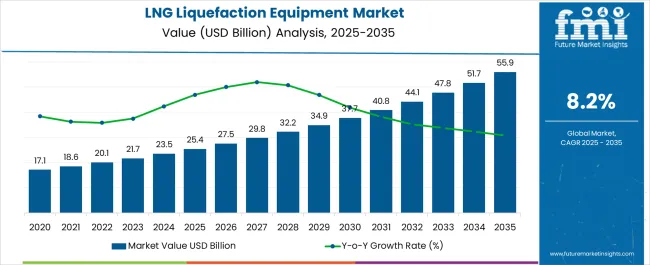
| Metric | Value |
|---|---|
| LNG Liquefaction Equipment Market Estimated Value in (2025 E) | USD 25.4 billion |
| LNG Liquefaction Equipment Market Forecast Value in (2035 F) | USD 55.9 billion |
| Forecast CAGR (2025 to 2035) | 8.2% |
The LNG Liquefaction Equipment market is experiencing significant growth, driven by increasing global demand for liquefied natural gas as a cleaner energy alternative and as a means to diversify energy supply. Investments in liquefaction infrastructure are being supported by rising energy consumption in emerging economies and long-term natural gas contracts between producers and importers. The adoption of advanced equipment and systems enables higher efficiency, lower energy consumption, and enhanced reliability in LNG production.
Technological advancements, including modular plant designs, improved refrigerant management, and automation, are enhancing operational performance while reducing environmental impact. Integration of high-capacity compressors and optimized liquefaction processes ensures scalability for different plant sizes.
Growing interest in mid-scale and small-scale LNG plants to serve niche or regional markets is further shaping demand With continued focus on decarbonization, energy security, and operational efficiency, the LNG liquefaction equipment market is poised for sustained expansion, driven by innovations in systems, equipment, and process optimization.
The lng liquefaction equipment market is segmented by systems, equipment manufacturer, plant size, and geographic regions. By systems, lng liquefaction equipment market is divided into Refrigerant Compressor System, Pumping And Storage System, Power System, and Other Auxiliary System. In terms of equipment manufacturer, lng liquefaction equipment market is classified into Plant Manufacturer and Assembly Manufacturer. Based on plant size, lng liquefaction equipment market is segmented into Mid-Scale LNG Plants (>0.25 To <2.0 MTPA), Small LNG Plants (<0.25 MTPA), Large LNG Plants (>2.0 MTPA), and FLNG Plants (Offshore Floating Plants). Regionally, the lng liquefaction equipment industry is classified into North America, Latin America, Western Europe, Eastern Europe, Balkan & Baltic Countries, Russia & Belarus, Central Asia, East Asia, South Asia & Pacific, and the Middle East & Africa.
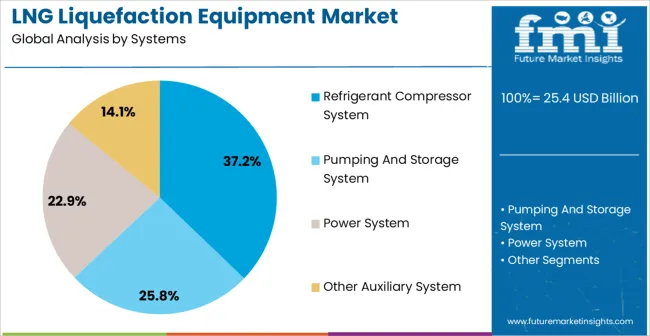
The refrigerant compressor system segment is projected to hold 37.2% of the LNG liquefaction equipment market revenue in 2025, establishing it as the leading systems category. Growth in this segment is being driven by the critical role these compressors play in the liquefaction cycle, enabling efficient cooling and gas-to-liquid conversion while maintaining operational stability.
Technological advancements in compressor design, energy efficiency, and reliability have improved performance and reduced downtime, supporting widespread adoption in both new and retrofitted LNG plants. The modular and scalable nature of these systems allows for integration with mid-scale and large-scale liquefaction facilities.
Increasing investments in energy-efficient solutions and lower lifecycle costs have further reinforced their market position With global LNG demand rising and operational efficiency becoming a priority, refrigerant compressor systems are expected to maintain their leadership position, providing critical functionality that underpins plant performance and energy optimization in liquefaction operations.
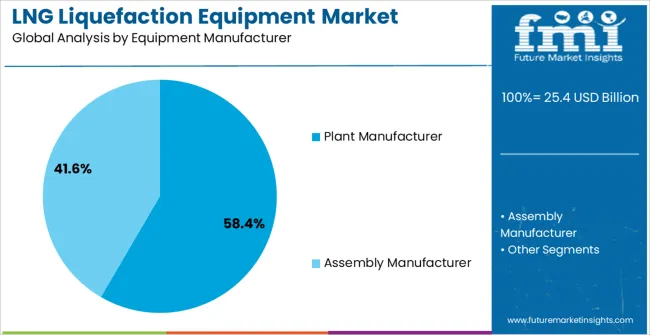
The plant manufacturer segment is anticipated to account for 58.4% of the LNG liquefaction equipment market revenue in 2025, making it the largest equipment manufacturer category. Growth in this segment is being supported by increasing demand for turnkey solutions, design expertise, and integrated systems that enable optimized plant performance.
Manufacturers offering comprehensive engineering, procurement, and construction capabilities are gaining preference due to their ability to deliver reliable, efficient, and scalable liquefaction facilities. These manufacturers are investing in technology development to improve energy efficiency, reduce emissions, and ensure long-term operational reliability.
Strategic collaborations with equipment suppliers and technology licensors further enhance their competitiveness As mid-scale LNG plants expand and new projects are commissioned globally, plant manufacturers are expected to remain the dominant equipment provider, driven by their proven track record, integrated solutions, and capability to meet evolving market requirements.
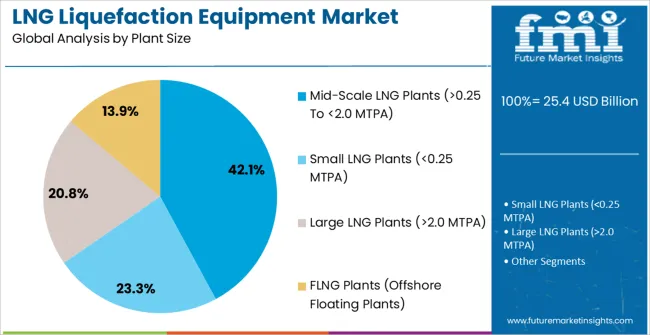
The mid-scale LNG plants segment is projected to hold 42.1% of the market revenue in 2025, establishing it as the leading plant size category. Its prominence is being driven by the growing need for flexible and cost-effective liquefaction capacity that can serve regional markets, smaller import terminals, or niche industrial applications.
Mid-scale plants offer faster project execution timelines, lower capital expenditure, and scalable operation, making them suitable for markets with moderate demand. Technological advancements in modular construction, compact liquefaction systems, and efficient refrigerant management enable reliable performance at reduced costs.
Rising adoption of mid-scale plants is further supported by energy security initiatives, regional natural gas production, and increasing LNG trade flows As global demand for liquefied natural gas continues to diversify across emerging and developed markets, mid-scale LNG plants are expected to remain a key growth driver, providing operational flexibility, optimized efficiency, and faster returns on investment.
Liquefied natural gas (LNG) is the liquid form of natural gas at cryogenic temperature of −161°C (−157°C). Liquefaction of natural gas shrinks its volume by a factor of approximately 600 hence, allowing easy and economical transport over long distances.
The set of equipment aligned in series, designed to treat and liquefy natural gas are known as LNG train. With the increasing demand of LNG as the source of fuel, the global LNG liquefaction equipment market has grown steadily in the past few years.
The LNG liquefaction equipment accounts up to total 30% total project cost of a liquefaction plant. Hence, LNG liquefaction equipment has been a key area in constant need of innovation and development to save cost, increase LNG plant capacity and improving pant efficiency.
Natural gas is one of the world’s most needed feedstock and with the ever growing demand of clean energy source LNG demand is rising, hence driving the LNG liquefaction equipment market. The LNG liquefaction equipment market possesses pronounced growth opportunities for the growth of new as well as established players.
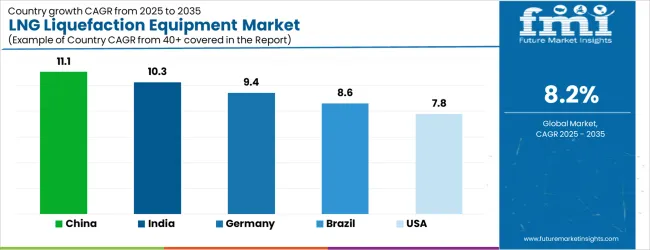
| Country | CAGR |
|---|---|
| China | 11.1% |
| India | 10.3% |
| Germany | 9.4% |
| Brazil | 8.6% |
| USA | 7.8% |
| UK | 7.0% |
| Japan | 6.2% |
The LNG Liquefaction Equipment Market is expected to register a CAGR of 8.2% during the forecast period, exhibiting varied country level momentum. China leads with the highest CAGR of 11.1%, followed by India at 10.3%. Developed markets such as Germany, France, and the UK continue to expand steadily, while the USA is likely to grow at consistent rates. Japan posts the lowest CAGR at 6.2%, yet still underscores a broadly positive trajectory for the global LNG Liquefaction Equipment Market. In 2024, Germany held a dominant revenue in the Western Europe market and is expected to grow with a CAGR of 9.4%. The USA LNG Liquefaction Equipment Market is estimated to be valued at USD 8.9 billion in 2025 and is anticipated to reach a valuation of USD 8.9 billion by 2035. Sales are projected to rise at a CAGR of 0.0% over the forecast period between 2025 and 2035. While Japan and South Korea markets are estimated to be valued at USD 1.2 billion and USD 887.1 million respectively in 2025.
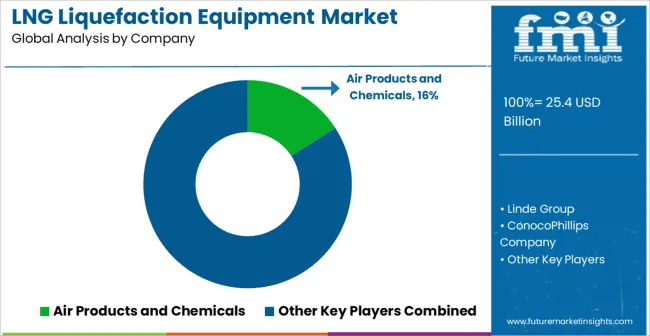
| Item | Value |
|---|---|
| Quantitative Units | USD 25.4 Billion |
| Systems | Refrigerant Compressor System, Pumping And Storage System, Power System, and Other Auxiliary System |
| Equipment Manufacturer | Plant Manufacturer and Assembly Manufacturer |
| Plant Size | Mid-Scale LNG Plants (>0.25 To <2.0 MTPA), Small LNG Plants (<0.25 MTPA), Large LNG Plants (>2.0 MTPA), and FLNG Plants (Offshore Floating Plants) |
| Regions Covered | North America, Europe, Asia-Pacific, Latin America, Middle East & Africa |
| Country Covered | United States, Canada, Germany, France, United Kingdom, China, Japan, India, Brazil, South Africa |
| Key Companies Profiled | Air Products and Chemicals, Linde Group, ConocoPhillips Company, Atlas Copco, Ingersoll Rand, General Electric, Kobelco Compressors, Chart Energy and Chemicals, Elliott, MITSUI E&S, MCO, and IHI Corporation |
The global lng liquefaction equipment market is estimated to be valued at USD 25.4 billion in 2025.
The market size for the lng liquefaction equipment market is projected to reach USD 55.9 billion by 2035.
The lng liquefaction equipment market is expected to grow at a 8.2% CAGR between 2025 and 2035.
The key product types in lng liquefaction equipment market are refrigerant compressor system, pumping and storage system, power system and other auxiliary system.
In terms of equipment manufacturer, plant manufacturer segment to command 58.4% share in the lng liquefaction equipment market in 2025.






Our Research Products

The "Full Research Suite" delivers actionable market intel, deep dives on markets or technologies, so clients act faster, cut risk, and unlock growth.

The Leaderboard benchmarks and ranks top vendors, classifying them as Established Leaders, Leading Challengers, or Disruptors & Challengers.

Locates where complements amplify value and substitutes erode it, forecasting net impact by horizon

We deliver granular, decision-grade intel: market sizing, 5-year forecasts, pricing, adoption, usage, revenue, and operational KPIs—plus competitor tracking, regulation, and value chains—across 60 countries broadly.

Spot the shifts before they hit your P&L. We track inflection points, adoption curves, pricing moves, and ecosystem plays to show where demand is heading, why it is changing, and what to do next across high-growth markets and disruptive tech

Real-time reads of user behavior. We track shifting priorities, perceptions of today’s and next-gen services, and provider experience, then pace how fast tech moves from trial to adoption, blending buyer, consumer, and channel inputs with social signals (#WhySwitch, #UX).

Partner with our analyst team to build a custom report designed around your business priorities. From analysing market trends to assessing competitors or crafting bespoke datasets, we tailor insights to your needs.
Supplier Intelligence
Discovery & Profiling
Capacity & Footprint
Performance & Risk
Compliance & Governance
Commercial Readiness
Who Supplies Whom
Scorecards & Shortlists
Playbooks & Docs
Category Intelligence
Definition & Scope
Demand & Use Cases
Cost Drivers
Market Structure
Supply Chain Map
Trade & Policy
Operating Norms
Deliverables
Buyer Intelligence
Account Basics
Spend & Scope
Procurement Model
Vendor Requirements
Terms & Policies
Entry Strategy
Pain Points & Triggers
Outputs
Pricing Analysis
Benchmarks
Trends
Should-Cost
Indexation
Landed Cost
Commercial Terms
Deliverables
Brand Analysis
Positioning & Value Prop
Share & Presence
Customer Evidence
Go-to-Market
Digital & Reputation
Compliance & Trust
KPIs & Gaps
Outputs
Full Research Suite comprises of:
Market outlook & trends analysis
Interviews & case studies
Strategic recommendations
Vendor profiles & capabilities analysis
5-year forecasts
8 regions and 60+ country-level data splits
Market segment data splits
12 months of continuous data updates
DELIVERED AS:
PDF EXCEL ONLINE
LNG Intermediate Fluid Vaporizer (IFV) Market Size and Share Forecast Outlook 2025 to 2035
LNG Open Rack Vaporizer (ORV) Market Size and Share Forecast Outlook 2025 to 2035
LNG Marine Gensets Market Size and Share Forecast Outlook 2025 to 2035
LNG Tank Containers Market Size and Share Forecast Outlook 2025 to 2035
Equipment Management Software Market Size and Share Forecast Outlook 2025 to 2035
LNG Bunkering Market Size and Share Forecast Outlook 2025 to 2035
Equipment cases market Size and Share Forecast Outlook 2025 to 2035
LNG Terminal Market Size and Share Forecast Outlook 2025 to 2035
LNG Virtual Pipeline Market Size and Share Forecast Outlook 2025 to 2035
LNG Storage Tank Market Growth - Trends & Forecast 2025 to 2035
Farm Equipment Market Forecast and Outlook 2025 to 2035
Golf Equipment Market Size and Share Forecast Outlook 2025 to 2035
Port Equipment Market Size and Share Forecast Outlook 2025 to 2035
Pouch Equipment Market Growth – Demand, Trends & Outlook 2025 to 2035
Garage Equipment Market Forecast and Outlook 2025 to 2035
Mining Equipment Industry Analysis in Latin America Size and Share Forecast Outlook 2025 to 2035
Subsea Equipment Market Size and Share Forecast Outlook 2025 to 2035
Pavers Equipment Market Size and Share Forecast Outlook 2025 to 2035
Tennis Equipment Market Analysis - Size, Share, and Forecast Outlook 2025 to 2035
Galley Equipment Market Analysis and Forecast by Fit, Application, and Region through 2035

Thank you!
You will receive an email from our Business Development Manager. Please be sure to check your SPAM/JUNK folder too.
Chat With
MaRIA